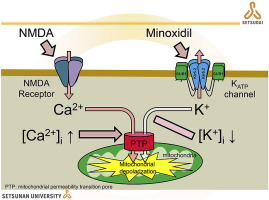当前位置:
X-MOL 学术
›
Neurochem. Int.
›
论文详情
Our official English website, www.x-mol.net, welcomes your feedback! (Note: you will need to create a separate account there.)
Regulatory effects associated with changes in intracellular potassium level in susceptibility to mitochondrial depolarization and excitotoxicity.
Neurochemistry international ( IF 4.2 ) Pub Date : 2019-12-02 , DOI: 10.1016/j.neuint.2019.104627 Hiroshi Higashi 1 , Toshihiko Kinjo 1 , Kyosuke Uno 1 , Nobuyuki Kuramoto 1
Neurochemistry international ( IF 4.2 ) Pub Date : 2019-12-02 , DOI: 10.1016/j.neuint.2019.104627 Hiroshi Higashi 1 , Toshihiko Kinjo 1 , Kyosuke Uno 1 , Nobuyuki Kuramoto 1
Affiliation

|
Excitotoxicity has been believed to be one of the causes of neurodegenerative diseases such as Alzheimer's disease and Huntington's disease. So far, much research has been done to suppress the neuronal excessive excitations, however, we still have not achieved full control, which may be due to the lack of some factors. As a matter of course, there is an urgent need to clarify all mechanisms that inhibit the onset and progression of neurodegenerative diseases. We found that potassium ion level regulation may be important in the sense that it suppresses mitochondrial depolarization rather than hyperpolarization of cell membrane potential. Minoxidil, an opener of ATP-activated potassium (KATP) channels decreased injury with middle cerebral artery occlusion in vivo experiment using TTC staining. In the primary cortical neurons, N-methyl-D-aspartate (NMDA)-induced mitochondrial depolarization was suppressed by minoxidil treatment. Minoxidil inhibited the increase in levels of cleaved caspase 3 and the release of cytochrome c into the cytosol, further reducing potassium ion levels. It was observed decreased potassium levels in neurons by the treatment of minoxidil. Those effects of minoxidil were blocked by glibenclamide. Therefore, it was suggested that minoxidil, via opening of KATP channels, reduced intracellular potassium ion level that contribute to mitochondrial depolarization, and suppressed subsequent NMDA-induced mitochondrial depolarization. Our findings suggest that the control of ion levels in neurons could dominate the onset and progression of neurodegenerative diseases.
中文翻译:

调节作用与细胞内钾水平变化对线粒体去极化和兴奋性毒性的敏感性有关。
兴奋性毒性被认为是神经退行性疾病例如阿尔茨海默氏病和亨廷顿氏病的原因之一。到目前为止,已经进行了很多研究来抑制神经元的过度兴奋,但是,我们仍未实现完全控制,这可能是由于缺少某些因素所致。当然,迫切需要阐明所有抑制神经变性疾病发作和发展的机制。我们发现钾离子水平调节在抑制线粒体去极化而不是细胞膜电位超极化的意义上可能很重要。使用TTC染色的体内实验表明,米诺地尔是ATP激活钾(KATP)通道的开放剂,可减轻大脑中动脉闭塞的损伤。在原代皮层神经元中 米诺地尔治疗可抑制N-甲基-D-天冬氨酸(NMDA)诱导的线粒体去极化。米诺地尔抑制裂解的胱天蛋白酶3水平的增加和细胞色素c释放到细胞质中,进一步降低了钾离子水平。观察到米诺地尔治疗可降低神经元中的钾水平。米诺地尔的那些作用被格列本脲阻断。因此,有人建议米诺地尔通过打开KATP通道,降低细胞内钾离子水平,从而促进线粒体去极化,并抑制随后的NMDA诱导的线粒体去极化。我们的发现表明,神经元中离子水平的控制可能主导神经退行性疾病的发作和发展。米诺地尔抑制裂解的胱天蛋白酶3水平的增加和细胞色素c释放到细胞质中,进一步降低了钾离子水平。观察到米诺地尔治疗可降低神经元中的钾水平。米诺地尔的那些作用被格列本脲阻断。因此,有人建议米诺地尔通过打开KATP通道,降低细胞内钾离子水平,从而促进线粒体去极化,并抑制随后的NMDA诱导的线粒体去极化。我们的发现表明,神经元中离子水平的控制可能主导神经退行性疾病的发作和发展。米诺地尔抑制裂解的胱天蛋白酶3水平的增加和细胞色素c释放到细胞质中,进一步降低了钾离子水平。观察到米诺地尔治疗可降低神经元中的钾水平。米诺地尔的那些作用被格列本脲阻断。因此,有人建议米诺地尔通过打开KATP通道,降低细胞内钾离子水平,从而促进线粒体去极化,并抑制随后的NMDA诱导的线粒体去极化。我们的发现表明,神经元中离子水平的控制可能主导神经退行性疾病的发作和发展。观察到米诺地尔治疗可降低神经元中的钾水平。米诺地尔的那些作用被格列本脲阻断。因此,有人建议米诺地尔通过打开KATP通道,降低细胞内钾离子水平,从而促进线粒体去极化,并抑制随后的NMDA诱导的线粒体去极化。我们的发现表明,神经元中离子水平的控制可能主导神经退行性疾病的发作和发展。观察到米诺地尔治疗可降低神经元中的钾水平。米诺地尔的那些作用被格列本脲阻断。因此,建议米诺地尔通过打开KATP通道,降低细胞内钾离子水平,从而促进线粒体去极化,并抑制随后的NMDA诱导的线粒体去极化。我们的发现表明,神经元中离子水平的控制可能主导神经退行性疾病的发作和发展。
更新日期:2019-12-03
中文翻译:

调节作用与细胞内钾水平变化对线粒体去极化和兴奋性毒性的敏感性有关。
兴奋性毒性被认为是神经退行性疾病例如阿尔茨海默氏病和亨廷顿氏病的原因之一。到目前为止,已经进行了很多研究来抑制神经元的过度兴奋,但是,我们仍未实现完全控制,这可能是由于缺少某些因素所致。当然,迫切需要阐明所有抑制神经变性疾病发作和发展的机制。我们发现钾离子水平调节在抑制线粒体去极化而不是细胞膜电位超极化的意义上可能很重要。使用TTC染色的体内实验表明,米诺地尔是ATP激活钾(KATP)通道的开放剂,可减轻大脑中动脉闭塞的损伤。在原代皮层神经元中 米诺地尔治疗可抑制N-甲基-D-天冬氨酸(NMDA)诱导的线粒体去极化。米诺地尔抑制裂解的胱天蛋白酶3水平的增加和细胞色素c释放到细胞质中,进一步降低了钾离子水平。观察到米诺地尔治疗可降低神经元中的钾水平。米诺地尔的那些作用被格列本脲阻断。因此,有人建议米诺地尔通过打开KATP通道,降低细胞内钾离子水平,从而促进线粒体去极化,并抑制随后的NMDA诱导的线粒体去极化。我们的发现表明,神经元中离子水平的控制可能主导神经退行性疾病的发作和发展。米诺地尔抑制裂解的胱天蛋白酶3水平的增加和细胞色素c释放到细胞质中,进一步降低了钾离子水平。观察到米诺地尔治疗可降低神经元中的钾水平。米诺地尔的那些作用被格列本脲阻断。因此,有人建议米诺地尔通过打开KATP通道,降低细胞内钾离子水平,从而促进线粒体去极化,并抑制随后的NMDA诱导的线粒体去极化。我们的发现表明,神经元中离子水平的控制可能主导神经退行性疾病的发作和发展。米诺地尔抑制裂解的胱天蛋白酶3水平的增加和细胞色素c释放到细胞质中,进一步降低了钾离子水平。观察到米诺地尔治疗可降低神经元中的钾水平。米诺地尔的那些作用被格列本脲阻断。因此,有人建议米诺地尔通过打开KATP通道,降低细胞内钾离子水平,从而促进线粒体去极化,并抑制随后的NMDA诱导的线粒体去极化。我们的发现表明,神经元中离子水平的控制可能主导神经退行性疾病的发作和发展。观察到米诺地尔治疗可降低神经元中的钾水平。米诺地尔的那些作用被格列本脲阻断。因此,有人建议米诺地尔通过打开KATP通道,降低细胞内钾离子水平,从而促进线粒体去极化,并抑制随后的NMDA诱导的线粒体去极化。我们的发现表明,神经元中离子水平的控制可能主导神经退行性疾病的发作和发展。观察到米诺地尔治疗可降低神经元中的钾水平。米诺地尔的那些作用被格列本脲阻断。因此,建议米诺地尔通过打开KATP通道,降低细胞内钾离子水平,从而促进线粒体去极化,并抑制随后的NMDA诱导的线粒体去极化。我们的发现表明,神经元中离子水平的控制可能主导神经退行性疾病的发作和发展。


























 京公网安备 11010802027423号
京公网安备 11010802027423号